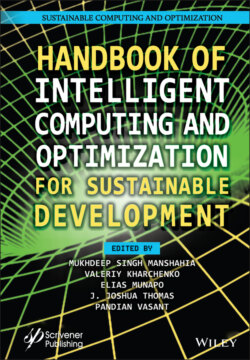Читать книгу Handbook of Intelligent Computing and Optimization for Sustainable Development - Группа авторов - Страница 37
2.1 Introduction
ОглавлениеArtificial neural network (ANN) is one of the most successfully implemented tools in the domain of machine learning. As the name suggests, ANN mimics human nervous system. The nervous system is the most versatile and complicated accomplishment of human evolution. It receives sensation, generates the responses, and affects cognitive functioning, learning, and behavior of an individual. ANN can be compared to interconnected neurons like human neurons which are capable of passing information from one neuron to other. These connections are called synapses to which numeric weights are associated. These synaptic weights can be set depending on learning both from past experience and current situation.
Neural networks or percetrons have been cultivated since 1940s and it has become a competent domain of artificial intelligence. It consists of input layer, hidden layer, and output layer. The hidden layer is consists of one or more layers depending on the complexity of the problem. The units of hidden layer transform the input into something that the output layer can use. Neural networks are used as efficient tools to generate complex patterns which are quiet impossible for a human programmer to extract and teach the machine to recognize. ANN has several computational applications, such as speech recognition, pattern classification, machine diagnostics, target recognition, process modeling and control, and medical diagnosis.
The intention of this chapter is to theoretically build the backbone of DNA computer. DNA molecules are competent to store, process, and retrieve information which motivates the notion of DNA computing. In this chapter, we focus to replace the mathematical and logical aspect of artificial intelligence by the unique chemical properties and characteristics of DNA molecules. DNA computing is the emerging domain in computational world and the modern technology is gradually approaching toward the paradigm shift, from silicon to carbon, where DNA computing is overcoming the drawbacks of classical silicon-based computing. We demonstrate the use of DNA oligonucleotides to develop the models of ANN. The input and output signal, which constructs the basic architecture of the neuron, has been encoded in terms of short DNA sequences.
The activity of the brain resembles the computer as it functions as an input-output device. The basic design of digital computer follows Boolean algebra. Thus, there is a sheer possibility of the brain to use Boolean algebra. As the input and output of the neural model are binary numbers, thus the multi-layer neural network can implement the basic logic gates, i.e., AND, OR, and NOT. This can be achieved by appropriately choosing the weights. In this chapter, we illustrate the design strategy of logical gates using the secondary structures of DNA molecules. DNA logic circuits, which are the alternatives to complex Boolean circuits, can be developed by the suitable use of DNA oligonucleotides and various enzymes. These DNA logic gates and logic circuits can be the pillars of a competent DNA computer in near future.
We also demonstrate the applications of DNA logic gates in real life. The successful development of DNA logic circuits accomplishes the basic requirement to design nano-DNA-devices. In the forthcoming generation, these nano-machines can be implanted in living organisms so that it could sense the conditions and accordingly can make decisions and respond to the situation. Based on the sensed circumstances, the nano-devices would be able to take required actions, for example, releasing medicines and killing hazardous cells.
In Section 2.2 of this chapter, we give a brief overview of biological neurons which is crucial to build the concept of ANN. Section 2.3 focuses on the short description of ANN which has been illustrated as the mathematical and computational tool for nonlinear statistical data modeling. DNA neural network is demonstrated in Section 2.4. Section 2.5 contains the developments on DNA logic gates, DNA logic circuits, and their applications. Finally, Section 2.6 concludes this chapter by focusing on the advent of DNA-based artificial intelligence.
